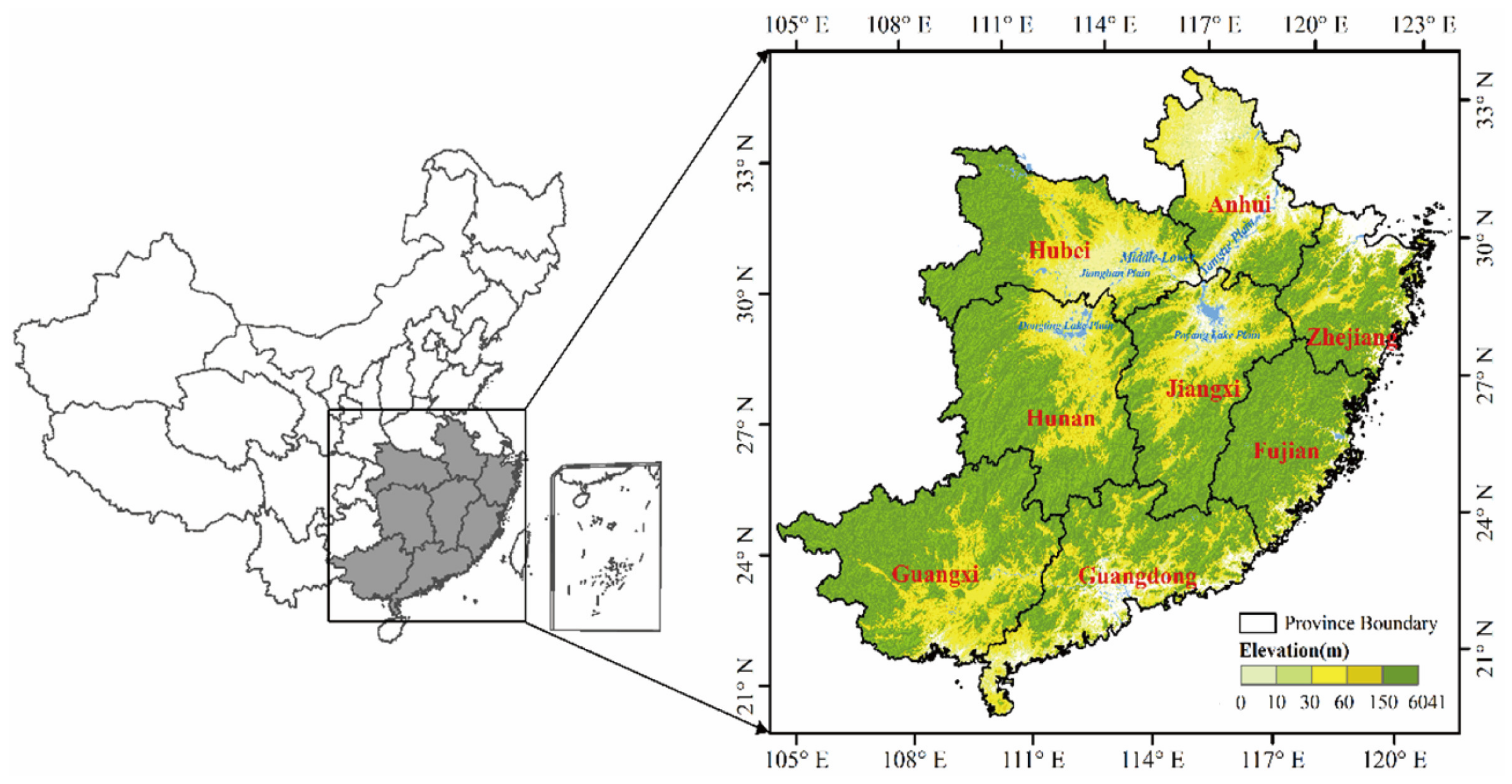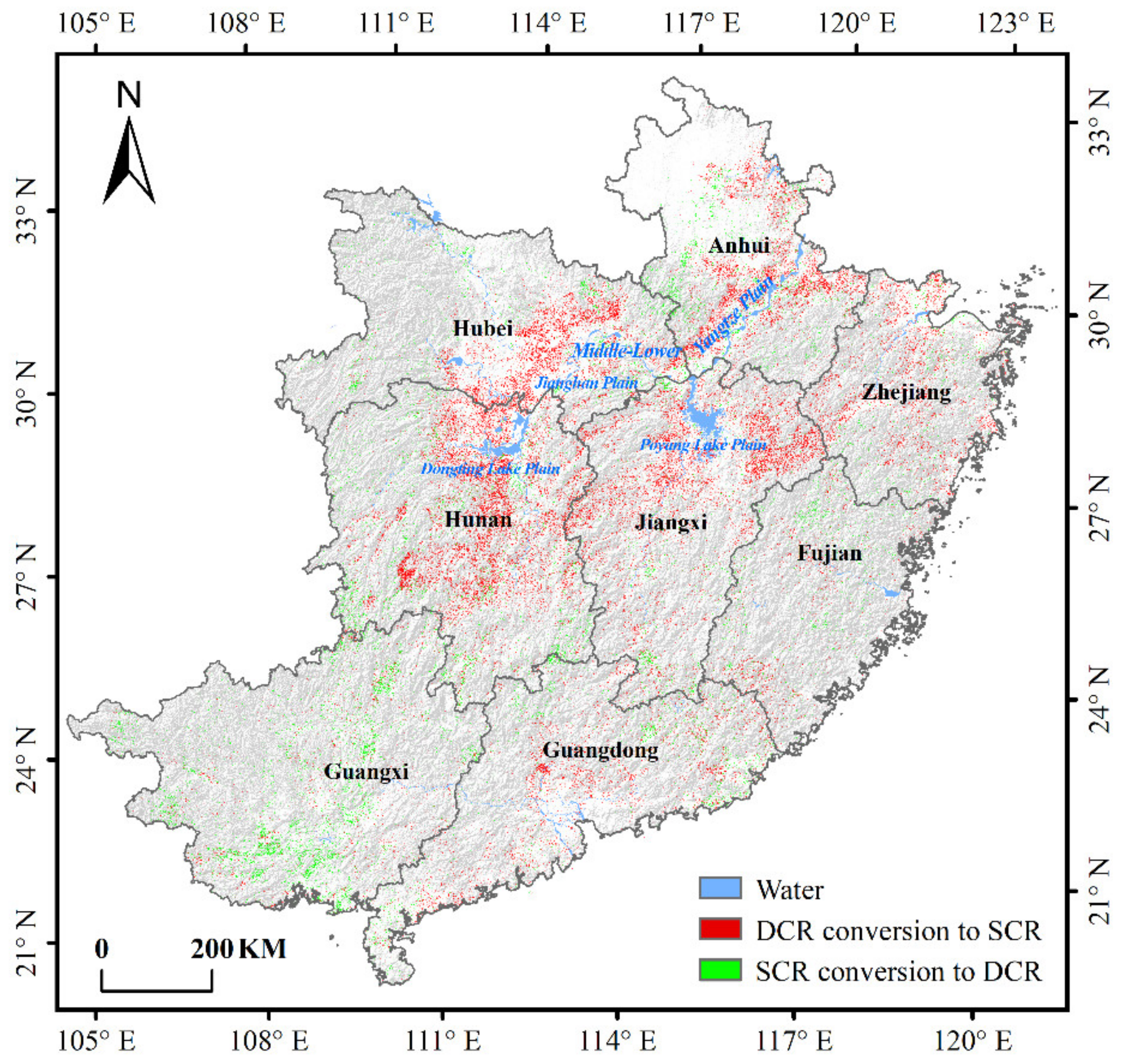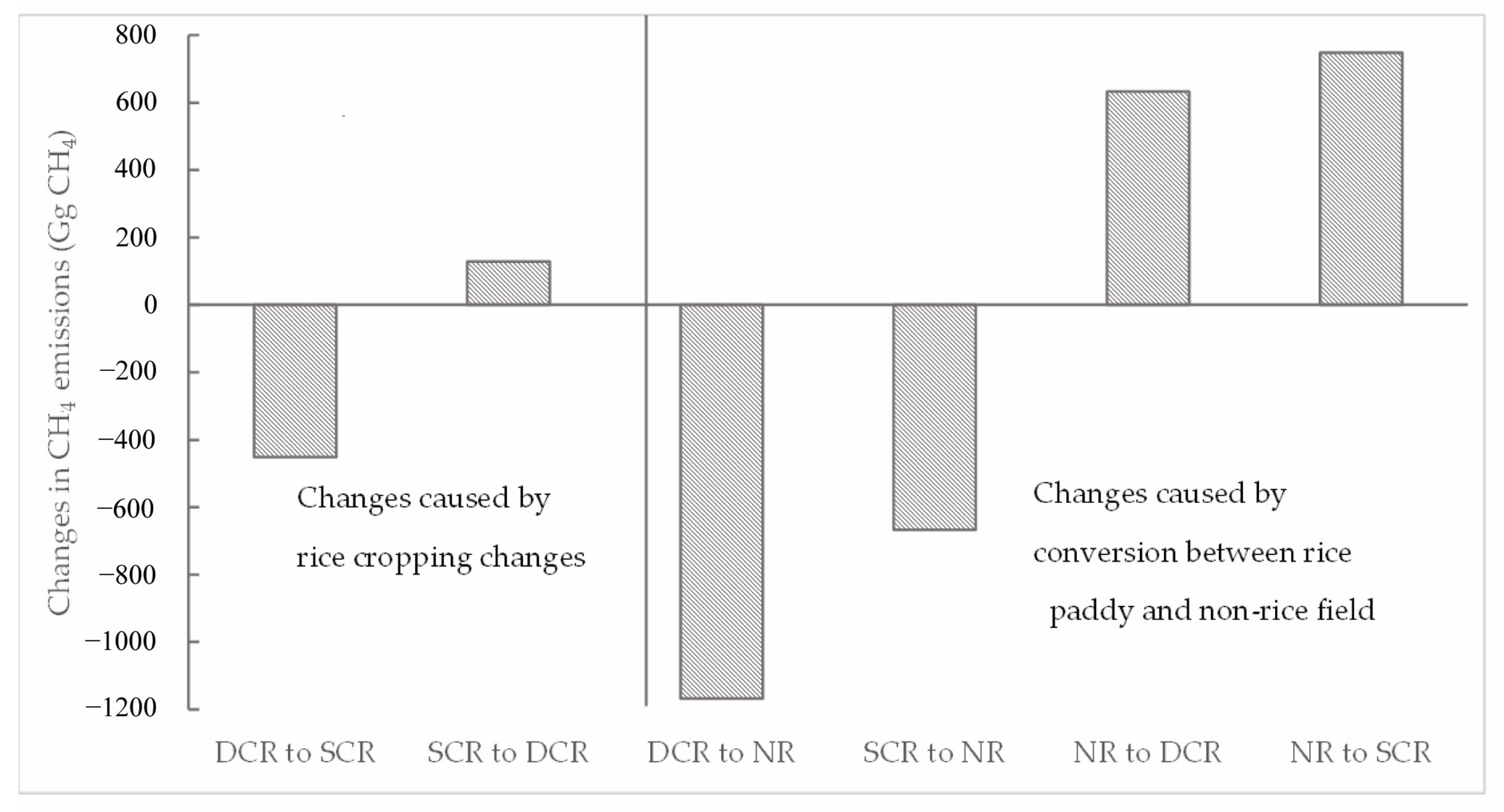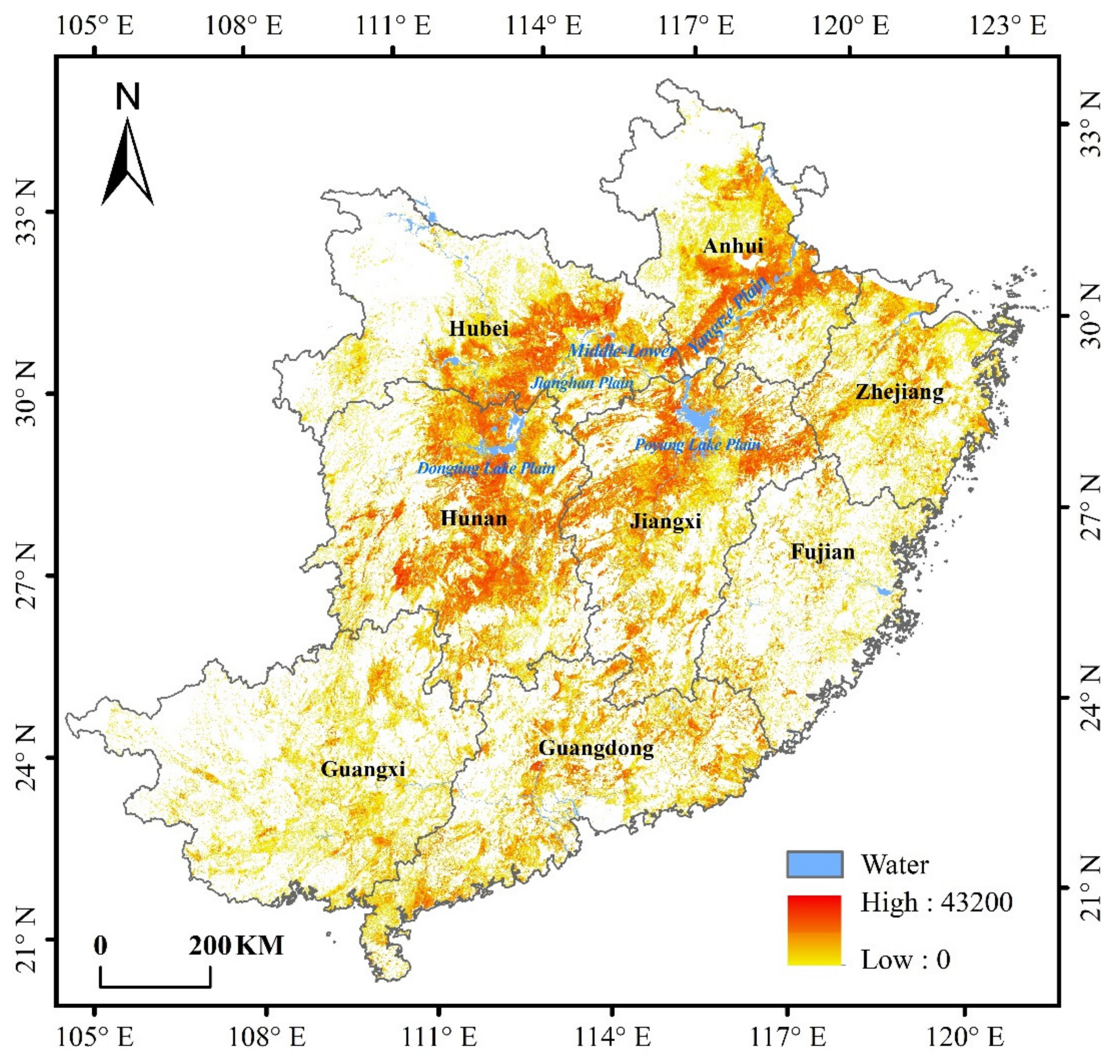Impacts of Rice Cropping System Changes on Paddy Methane Emissions in Southern China
Abstract
1. Introduction
2. Materials and Methods
2.1. Study Area
2.2. Calculating CH4 Emissions from Rice Paddies
2.3. Input Data for the CH4MOD Model
2.4. Maps of Rice Cropping Systems Distribution
2.5. Future Scenarios for Changes in CH4 Emissions from Rice Paddies
3. Results
3.1. Rice Cropping Systems Changes in Southern China from 1990 to 2015
3.2. Differences in CH4 flux Emissions
3.3. Temporal and Spatial Changes in CH4 Emissions from Rice Paddies
3.4. Changes in CH4 Emissions from Rice Paddies in Future Scenarios
4. Discussion
4.1. Implications for DCR Conversion to SCR
4.2. Uncertainties and Future Work
5. Conclusions
Author Contributions
Funding
Institutional Review Board Statement
Informed Consent Statement
Data Availability Statement
Acknowledgments
Conflicts of Interest
References
- Li, H.; Guo, H.-Q.; Helbig, M.; Dai, S.-Q.; Zhang, M.-S.; Zhao, M.; Peng, C.-H.; Xiao, X.-M.; Zhao, B. Does direct-seeded rice decrease ecosystem-scale methane emissions?—A case study from a rice paddy in southeast China. Agric. For. Meteorol. 2019, 272–273, 118–127. [Google Scholar] [CrossRef]
- Tian, Z.; Fan, Y.; Wang, K.; Zhong, H.; Sun, L.; Fan, D.; Tubiello, F.N.; Liu, J. Searching for “Win-Win” solutions for food-water-GHG emissions tradeoffs across irrigation regimes of paddy rice in China. Resour. Conserv. Recycl. 2021, 166, 105360. [Google Scholar] [CrossRef]
- IPCC. Climate Change 2021: The Physical Science Basis. Contribution of Working Group I to the Sixth Assessment Report of the Intergovernmental Panel on Climate Change; IPCC: Geneva, Switzerland, 2021. [Google Scholar]
- Bousquet, P.; Ciais, P.; Miller, J.B.; Dlugokencky, E.J.; Hauglustaine, D.A.; Prigent, C.; Van der Werf, G.R.; Peylin, P.; Brunke, E.G.; Carouge, C.; et al. Contribution of anthropogenic and natural sources to atmospheric methane variability. Nature 2006, 443, 439–443. [Google Scholar] [CrossRef] [PubMed]
- Smith, P.; Bustamante, M.; Ahammad, H.; Clark, H.; Dong, H.; Elsiddig, E.A.; Haberl, H.; Harper, R.; House, J.; Jafari, M.; et al. Agriculture, Forestry and Other Land Use (AFOLU). In Climate Change 2014: Mitigation of Climate Change. Contribution of Working Group III to the Fifth Assessment Report of the Intergovernmental Panel on Climate Change; Edenhofer, O., Pichs-Madruga, R., Sokona, Y., Farahani, E., Kadner, S., Seyboth, K., Adler, A., Baum, I., Brunner, S., Eickemeier, P., et al., Eds.; Cambridge University Press: Cambridge, UK, 2014. [Google Scholar]
- Nayak, D.; Saetnan, E.; Cheng, K.; Wang, W.; Koslowski, F.; Cheng, Y.-F.; Zhu, W.Y.; Wang, J.-K.; Liu, J.-X.; Moran, D.; et al. Management opportunities to mitigate greenhouse gas emissions from Chinese agriculture. Agric. Ecosyst. Environ. 2015, 209, 108–124. [Google Scholar] [CrossRef]
- Huang, J.; Wang, Y.; Wang, J. Farmers’ adaptation to extreme weather events through farm management and its impacts on the mean and risk of rice yield in China. Am. J. Agric. Econ. 2015, 97, 602–617. [Google Scholar] [CrossRef]
- Wu, W.; Yu, Q.; You, L.; Chen, K.; Tang, H.; Liu, J. Global cropping intensity gaps: Increasing food production without cropland expansion. Land Use Policy 2018, 76, 515–525. [Google Scholar] [CrossRef]
- Huang, Y.; Zhang, W.; Zheng, X.; Han, S.; Yu, Y. Estimates of methane emissions from Chinese rice paddies by linking a model to GIS database. Acta Ecol. Sin. 2006, 26, 980–987. [Google Scholar] [CrossRef]
- Qiu, B.; Qi, W.; Tang, Z.; Chen, C.; Wang, X. Rice cropping density and intensity lessened in southeast China during the twenty-first century. Environ. Monit. Assess. 2016, 188, 5. [Google Scholar] [CrossRef]
- Zhu, L.; Liu, X.; Wu, L.; Liu, M.; Lin, Y.; Meng, Y.; Ye, L.; Zhang, Q.; Li, Y. Detection of paddy rice cropping systems in southern China with time series Landsat images and phenology-based algorithms. GISci. Remote Sens. 2021, 58, 733–755. [Google Scholar] [CrossRef]
- Xin, L.; Li, X. Changes of Multiple Cropping in Double Cropping Rice Area of Southern China and Its Policy Implications. J. Nat. Resour. 2009, 24, 58–65. [Google Scholar] [CrossRef]
- National Bureau of Statistics of China. China Statistical Yearbook; Chinese Statistics Press: Beijing, China, 2020.
- Xie, H.; Wang, W.; Zhang, X. Evolutionary game and simulation of management strategies of fallow cultivated land: A case study in Hunan province, China. Land Use Policy 2018, 71, 86–97. [Google Scholar] [CrossRef]
- Lu, H.; Xie, H.; Lv, T.; Yao, G. Determinants of cultivated land recuperation in ecologically damaged areas in China. Land Use Policy 2019, 81, 160–166. [Google Scholar] [CrossRef]
- Hong, C.; Burney, J.A.; Pongratz, J.; Nabel, J.; Mueller, N.D.; Jackson, R.B.; Davis, S.J. Global and regional drivers of land-use emissions in 1961–2017. Nature 2021, 589, 554–561. [Google Scholar] [CrossRef] [PubMed]
- Zhang, B.; Tian, H.; Ren, W.; Tao, B.; Lu, C.; Yang, J.; Banger, K.; Pan, S. Methane emissions from global rice fields: Magnitude, spatiotemporal patterns, and environmental controls. Glob. Biogeochem. Cycles 2016, 30, 1246–1263. [Google Scholar] [CrossRef]
- Zhang, W.; Yu, Y.; Li, T.; Sun, W.; Huang, Y. Net greenhouse gas balance in China’s Croplands over the last three decades and its mitigation potential. Environ. Sci. Technol. 2014, 48, 2589–2597. [Google Scholar] [CrossRef]
- Zhang, W.; Yu, Y.; Huang, Y.; Li, T.; Wang, P. Modeling methane emissions from irrigated rice cultivation in China from 1960 to 2050. Glob. Chang. Biol. 2011, 17, 3511–3523. [Google Scholar] [CrossRef]
- Tian, Z.; Niu, Y.; Fan, D.; Sun, L.; Ficsher, G.; Zhong, H.; Deng, J.; Tubiello, F.N. Maintaining rice production while mitigating methane and nitrous oxide emissions from paddy fields in China: Evaluating tradeoffs by using coupled agricultural systems models. Agric. Syst. 2018, 159, 175–186. [Google Scholar] [CrossRef]
- Chen, H.; Yu, C.Q.; Li, C.S.; Xin, Q.C.; Huang, X.; Zhang, J.; Yue, Y.L.; Huang, G.R.; Li, X.C.; Wang, W. Modeling the impacts of water and fertilizer management on the ecosystem service of rice rotated cropping systems in China. Agric. Ecosyst. Environ. 2016, 219, 49–57. [Google Scholar] [CrossRef]
- Sun, J.; Wang, M.; Xu, X.; Cheng, K.; Yue, Q.; Pan, G. Re-estimating methane emissions from Chinese paddy fields based on a regional empirical model and high-spatial-resolution data. Environ. Pollut. 2020, 265, 115017. [Google Scholar] [CrossRef]
- Wang, J.; Akiyama, H.; Yagi, K.; Yan, X. Controlling variables and emission factors of methane from global rice fields. Atmos. Chem. Phys. 2018, 18, 10419–10431. [Google Scholar] [CrossRef]
- Yuan, Y.; Dai, X.; Wang, H.; Xu, M.; Fu, X.; Yang, F. Effects of Land-Use Conversion from Double Rice Cropping to Vegetables on Methane and Nitrous Oxide Fluxes in Southern China. PLoS ONE 2016, 11, e0155926. [Google Scholar] [CrossRef] [PubMed]
- Zhang, G.; Xiao, X.; Dong, J.; Xin, F.; Zhang, Y.; Qin, Y.; Doughty, R.B.; Moore, B., 3rd. Fingerprint of rice paddies in spatial-temporal dynamics of atmospheric methane concentration in monsoon Asia. Nat. Commun. 2020, 11, 554. [Google Scholar] [CrossRef] [PubMed]
- Zhao, Q.; Brocks, S.; Lenz-Wiedemann, V.I.S.; Miao, Y.; Zhang, F.; Bareth, G. Detecting spatial variability of paddy rice yield by combining the DNDC model with high resolution satellite images. Agric. Syst. 2017, 152, 47–57. [Google Scholar] [CrossRef]
- National Bureau of Statistics of China. China Statistical Yearbook; Chinese Statistics Press: Beijing, China, 2019. (In Chinese)
- Frolking, S.; Qiu, J.; Boles, S.; Xiao, X.; Liu, J.; Zhuang, Y.; Li, C.; Qin, X. Combining remote sensing and ground census data to develop new maps of the distribution of rice agriculture in China. Glob. Biogeochem. Cycles 2002, 16, 38-1–38-10. [Google Scholar] [CrossRef]
- Huang, Y.; Zhang, W.; Zheng, X.; Li, J.; Yu, Y. Modeling methane emission from rice paddies with various agricultural practices. J. Geophys. Res. D Atmos. 2004, 109, D08113. [Google Scholar] [CrossRef]
- Huang, Y.; Sass, R.L.; Fisher, J.; Frank, M. A semi-empirical model of methane emission from flooded rice paddy soils. Glob. Chang. Biol. 1998, 4, 247–268. [Google Scholar] [CrossRef]
- Eggleston, H.S.; Buendia, L.; Miwa, K.; Ngara, T.; Tanabe, K. 2006 IPCC Guidelines for National Greenhouse Gas Inventories; IPCC National Greenhouse Gas Inventories Programme, Intergovernmental Panel on Climate Change IPCC, c/o Institute for Global Environmental Strategies IGES, 2108-11; IPCC: Hayama, Japan, 2006. [Google Scholar]
- Verburg, P.H.; van Bodegom, P.M.; van der Gon, H.A.D.; Bergsma, A.; van Breemen, N. Upscaling regional emissions of greenhouse gases from rice cultivation: Methods and sources of uncertainty. Plant Ecol. 2006, 182, 89–106. [Google Scholar]
- Bogner, J.E.; Sass, R.L.; Walter, B.P. Model comparisons of methane oxidation across a management gradient: Wetlands, rice production systems, and landfill. Glob. Biogeochem. Cycles 2000, 14, 1021–1033. [Google Scholar]
- Xie, B.; Zhou, Z.; Zheng, X.; Zhang, W.; Zhu, J. Modeling methane emissions from paddy rice fields under elevated atmospheric carbon dioxide conditions. Adv. Atmos. Sci. 2010, 27, 100–114. [Google Scholar]
- Kai, F.M.; Tyler, S.C.; Randerson, J.T.; Blake, D.R. Reduced methane growth rate explained by decreased Northern Hemisphere microbial sources. Nature 2011, 476, 194–197. [Google Scholar] [CrossRef]
- Hutchinson, M.F.; Xu, T. Anusplin Version 4.2 User Guide; Centre for Resource and Environmental Studies, The Australian National University: Canberra, Australia, 2004; p. 54. [Google Scholar]
- Zhang, F.; Wang, D.; Qiu, B. Map of Agro-Climate in China; Science Press: Beijing, China, 1987. [Google Scholar]
- Jiang, M.; Xin, L.; Li, X.; Tan, M.; Wang, R. Decreasing Rice Cropping Intensity in Southern China from 1990 to 2015. Remote Sens. 2019, 11, 35. [Google Scholar]
- Jiang, L.; Deng, X.; Seto, K.C. The impact of urban expansion on agricultural land use intensity in China. Land Use Policy 2013, 35, 33–39. [Google Scholar]
- Tian, Q.; Jiang, L.; Lemos, M.; Qi, S. Interactions of social, natural, and technological subsystems and synergy between development and adaptation to floods around Poyang Lake. Ann. GIS 2018, 24, 209–220. [Google Scholar]
- Wang, R.; Li, X.; Tan, M.; Xin, L.; Wang, X.; Wang, Y.; Jiang, M. Inter-provincial differences in rice multi-cropping changes in main double-cropping rice area in China: Evidence from provinces and households. Chin. Geogr. Sci. 2019, 29, 12. [Google Scholar] [CrossRef]
- Wang, M. Methane Emission from Chinese Rice Paddies; Science Press: Beijing, China, 2001. [Google Scholar]
- Li, C.; Qiu, J.; Frolking, S.; Xiao, X.; Salas, W.; Moore, B.; Boles, S.; Huang, Y.; Sass, R. Reduced methane emissions from large-scale changes in water management of China’s rice paddies during 1980–2000. Geophys. Res. Lett. 2002, 29, 33-1–33-4. [Google Scholar] [CrossRef]
- Islam, S.F.; Sander, B.O.; Quilty, J.R.; de Neergaard, A.; van Groenigen, J.W.; Jensen, L.S. Mitigation of greenhouse gas emissions and reduced irrigation water use in rice production through water-saving irrigation scheduling, reduced tillage and fertiliser application strategies. Sci. Total Environ. 2020, 739, 140215. [Google Scholar] [CrossRef]
- Wassmann, R.; Lantin, R.; Neue, H.; Buendia, L.; Corton, T.; Lu, Y. Characterization of methane emissions from rice fields in Asia. III. Mitigation options and future research needs. Nutr. Cycl. Agroecosys. 2000, 58, 23–36. [Google Scholar] [CrossRef]
- Naser, H.M.; Nagata, O.; Tamura, S.; Hatano, R. Methane emissions from five paddy fields with different amounts of rice straw application in central Hokkaido, Japan. Soil Sci. Plant Nutr. 2007, 53, 95–101. [Google Scholar] [CrossRef]
- Cai, Z.; Xing, G.; Yan, X.; Xu, H.; Tsuruta, H.; Yagi, K.; Minami, K. Methane and nitrous oxide emissions from rice paddy fields as affected by nitrogen fertilisers and water management. Plant Soil 1997, 196, 7–14. [Google Scholar] [CrossRef]
- Lan, T.; Li, M.; Han, Y.; Deng, O.; Tang, X.; Luo, L.; Zeng, J.; Chen, G.; Yuan, S.; Wang, C.; et al. How are annual CH4, N2O, and NO emissions from rice–wheat system affected by nitrogen fertilizer rate and type? Appl. Soil Ecol. 2020, 150, 103469. [Google Scholar] [CrossRef]
- Jia, Z.; Cai, Z.; Tsuruta, H. Effect of rice cultivar on CH4 production potential of rice soil and CH4 emission in a pot experiment. Soil Sci. Plant Nutr. 2006, 52, 341–348. [Google Scholar] [CrossRef]
- Riya, S.; Zhou, S.; Watanabe, Y.; Sagehashi, M.; Terada, A.; Hosomi, M. CH4 and N2O emissions from different varieties of forage rice (Oryza sativa L.) treating liquid cattle waste. Sci. Total Environ. 2012, 419, 178–186. [Google Scholar] [PubMed]
- Franks, J.R.; Hadingham, B. Reducing greenhouse gas emissions from agriculture: Avoiding trivial solutions to a global problem. Land Use Policy 2012, 29, 727–736. [Google Scholar] [CrossRef]
- Lamb, A.; Green, R.; Bateman, I.; Broadmeadow, M.; Bruce, T.; Burney, J.; Carey, P.; Chadwick, D.; Crane, E.; Field, R.; et al. The potential for land sparing to offset greenhouse gas emissions from agriculture. Nat. Clim. Change 2016, 6, 488–492. [Google Scholar] [CrossRef]
- Smith, P.; Martino, D.; Cai, Z.; Gwary, D.; Janzen, H.; Kumar, P.; McCarl, B.; Ogle, S.; O’Mara, F.; Rice, C. Policy and technological constraints to implementation of greenhouse gas mitigation options in agriculture. Agric. Ecosyst. Environ. 2007, 118, 6–28. [Google Scholar] [CrossRef]
- Smith, P.; Martino, D.; Cai, Z.; Gwary, D.; Janzen, H.; Kumar, P.; McCarl, B.; Ogle, S.; O’Mara, F.; Rice, C. Greenhouse gas mitigation in agriculture. Philos. Trans. R. Soc. Lond. B: Biol. Sci. 2008, 363, 789–813. [Google Scholar] [PubMed]
- Jiang, M.; Li, X.; Xin, L.; Tan, M. Paddy rice multiple cropping index changes in Southern China. J. Geogr. Sci. 2019, 29, 1773–1787. [Google Scholar] [CrossRef]
- Zhang, W.; Sun, W.; Li, T. Uncertainties in the national inventory of methane emissions from rice cultivation: Field measurements and modeling approaches. Biogeosciences 2017, 14, 163–176. [Google Scholar] [CrossRef]
- Zhang, W.; Zhang, Q.; Huang, Y.; Li, T.T.; Bian, J.Y.; Han, P.F. Uncertainties in estimating regional methane emissions from rice paddies due to data scarcity in the modeling approach. Geosci. Model Dev. 2014, 7, 1211–1224. [Google Scholar] [CrossRef]
- Ogle, S.M.; Jay Breidt, F.; Eve, M.D.; Paustian, K. Uncertainty in estimating land use and management impacts on soil organic carbon storage for US agricultural lands between 1982 and 1997. Glob. Chang. Biol. 2003, 9, 1521–1542. [Google Scholar]





| Region | 2015 Double Cropping Rice Sown Area (Thousand Ha) | 2015 CH4 Emissions of Double Cropping Rice (Gg CH4) | 2015 CH4 Emissions of Single Cropping Rice (Gg CH4) | Reduction in CH4 Emissions (Gg CH4) | |
|---|---|---|---|---|---|
| Scenario 1 | Scenario 2 | ||||
| Anhui | 747.9 | 46.56 | 1037.09 | 46.56 | 46.56 |
| Fujian | 318.2 | 24.75 | 93.63 | 24.75 | 24.75 |
| Hubei | 348 | 34.22 | 754.71 | 34.22 | 34.22 |
| Hunan | 1422.6 | 165.98 | 566.86 | 165.98 | 165.98 |
| Jiangxi | 1491.5 | 142.89 | 521.72 | 142.89 | 142.89 |
| Zhejiang | 342.4 | 13.54 | 166.65 | 13.54 | 13.54 |
| Guangdong | 1777.8 | 219.21 | 400.44 | 219.21 | 0 |
| Guangxi | 1727.6 | 145.76 | 317.21 | 145.76 | 0 |
| Region I | 4670.6 | 427.94 | 3140.66 | 427.94 | 427.94 |
| Region II | 3505.4 | 364.97 | 717.65 | 364.97 | 0 |
| Southern China | 8176.1 | 792.91 | 3858.31 | 792.91 | 427.94 |
Disclaimer/Publisher’s Note: The statements, opinions and data contained in all publications are solely those of the individual author(s) and contributor(s) and not of MDPI and/or the editor(s). MDPI and/or the editor(s) disclaim responsibility for any injury to people or property resulting from any ideas, methods, instructions or products referred to in the content. |
© 2023 by the authors. Licensee MDPI, Basel, Switzerland. This article is an open access article distributed under the terms and conditions of the Creative Commons Attribution (CC BY) license (https://creativecommons.org/licenses/by/4.0/).
Share and Cite
Jiang, M.; Li, X.; Xin, L.; Tan, M.; Zhang, W. Impacts of Rice Cropping System Changes on Paddy Methane Emissions in Southern China. Land 2023, 12, 270. https://doi.org/10.3390/land12020270
Jiang M, Li X, Xin L, Tan M, Zhang W. Impacts of Rice Cropping System Changes on Paddy Methane Emissions in Southern China. Land. 2023; 12(2):270. https://doi.org/10.3390/land12020270
Chicago/Turabian StyleJiang, Min, Xiubin Li, Liangjie Xin, Minghong Tan, and Wen Zhang. 2023. "Impacts of Rice Cropping System Changes on Paddy Methane Emissions in Southern China" Land 12, no. 2: 270. https://doi.org/10.3390/land12020270
APA StyleJiang, M., Li, X., Xin, L., Tan, M., & Zhang, W. (2023). Impacts of Rice Cropping System Changes on Paddy Methane Emissions in Southern China. Land, 12(2), 270. https://doi.org/10.3390/land12020270







